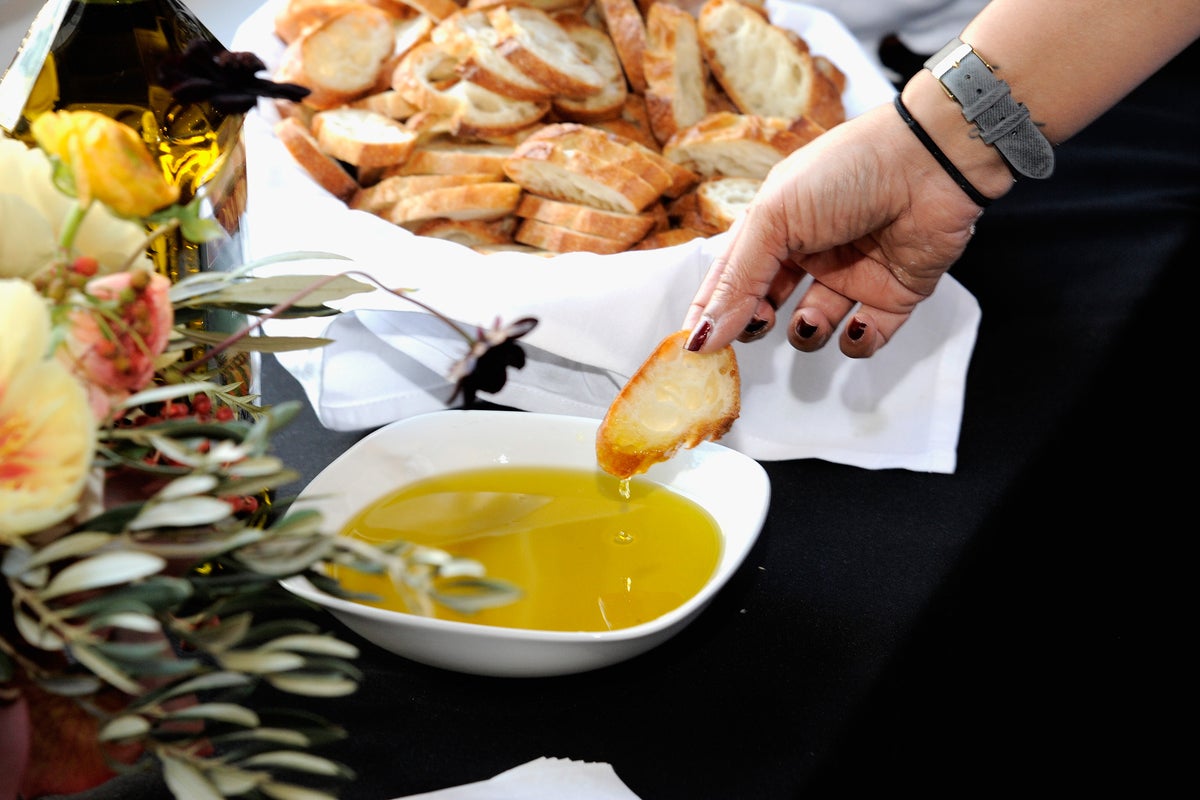Planning a picnic? These 5 easy bakes were made for eating in the sunshine
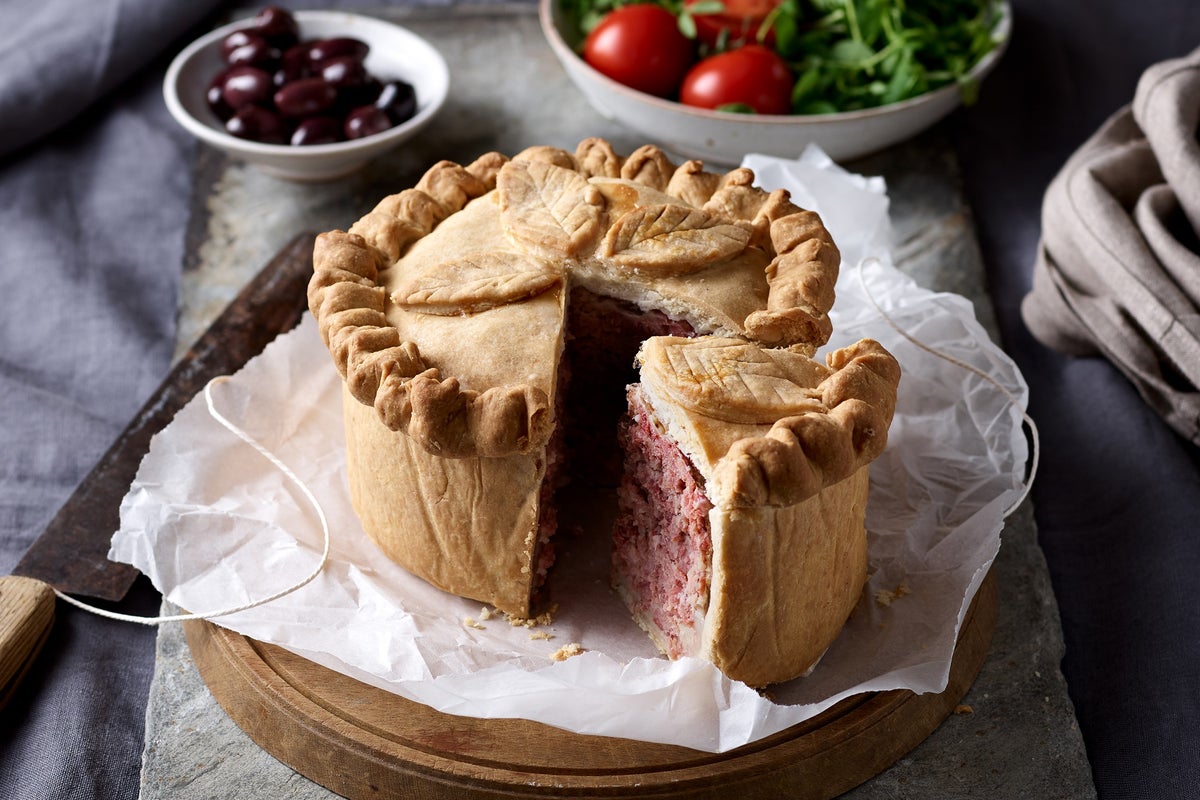
Picnic season is officially here – and whether you’re heading to the park with friends or laying out a lazy lunch in the garden, no spread is complete without a few homemade bakes. Think flaky sausage rolls, buttery jam tarts and a classic quiche to steal the show.
These five sweet and savoury recipes, shared by Doves Farm, are ideal for packing up and showing off. From crisp white rye scones to a traditional raised pork pie, they’re easy to make ahead and even easier to eat cold with your fingers. Just add a blanket and something chilled to drink.
Quiche lorraine
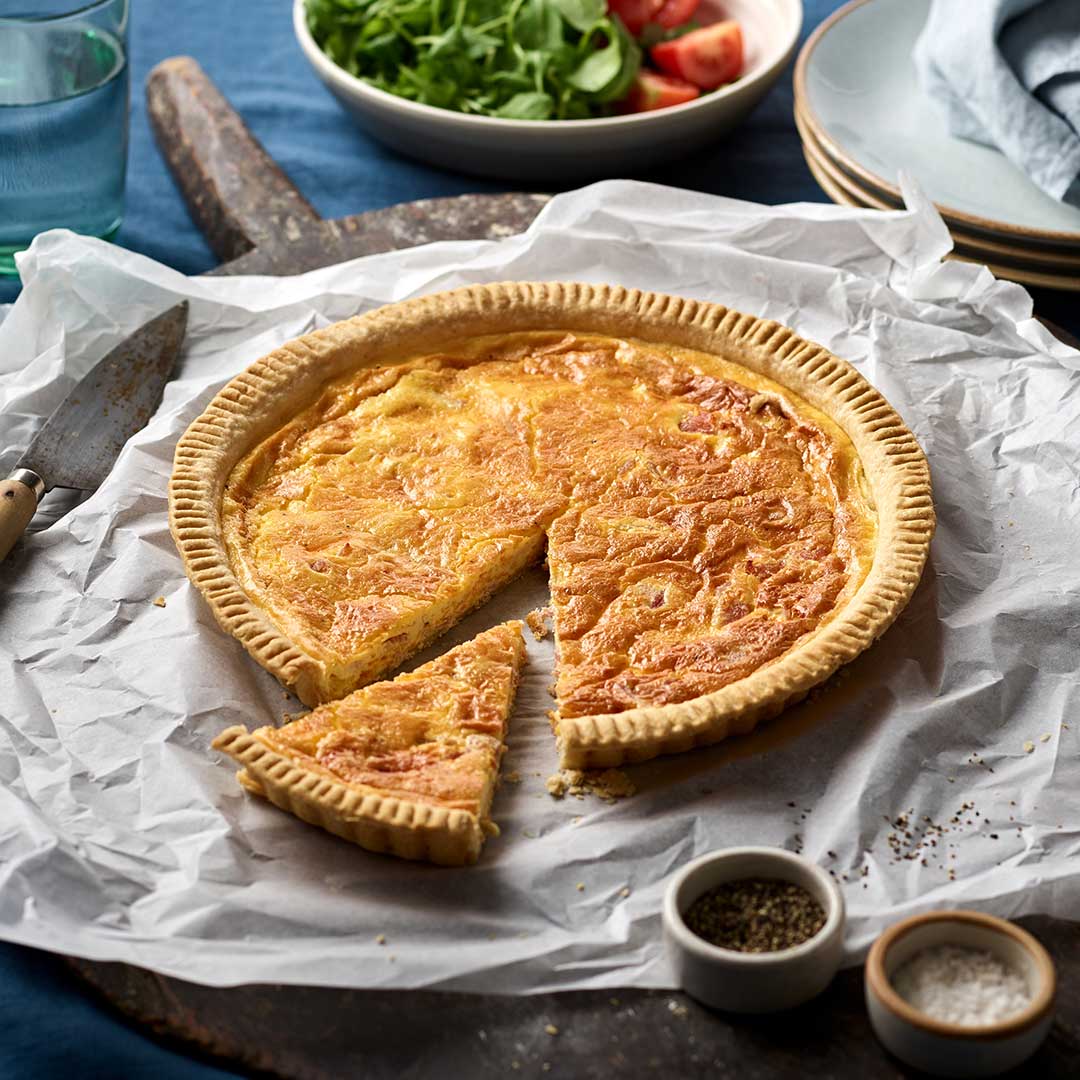
Time: 40-45 minutes
Equipment:
22cm/9” round baking dish or tin
Frying pan
Pastry blender
2 mixing bowls
Ingredients:
For the pastry:
200g plain white flour
Pinch of salt
100g butter
7-8 tbsp cold water
Flour, for dusting
Butter, for greasing
For the filling:
150g bacon
3 eggs
3 tbsp crème fraîche
75g cheese, grated
Salt and pepper
Method:
1. Pre-heat your oven to 180C (fan 160C/350F/gas 4).
For the pastry:
1. Rub some butter around a 23cm/9” round baking dish or tin.
2. Put the flour and salt into a mixing bowl.
3. Chop the butter into small cubes and add them to the bowl.
4. Using a fork or pastry blender, work the butter cubes into the flour until the mixture resembles breadcrumbs.
5. Stir in enough water to bring together a soft ball of dough.
6. Dust the work surface with flour, put the dough in the middle and sprinkle it with more flour.
7. Roll the pastry out into a circle 5cm/2” larger than your dish and lift it into the dish OR simply press the dough into the dish using your fingers.
8. Cut away any pastry that hangs over the edge of your dish.
For the filling:
9. Chop the bacon into a frying pan, cook until it changes colour without browning, then remove from the heat.
10. Break the eggs into a bowl, add the crème fraiche and beat well.
11. Grate the cheese into the bowl, add the cooked bacon, salt and pepper and mix well.
12. Pour the mixture into the pastry case.
13. Bake for 40-45 minutes.
Raised pork pie with hot water pastry
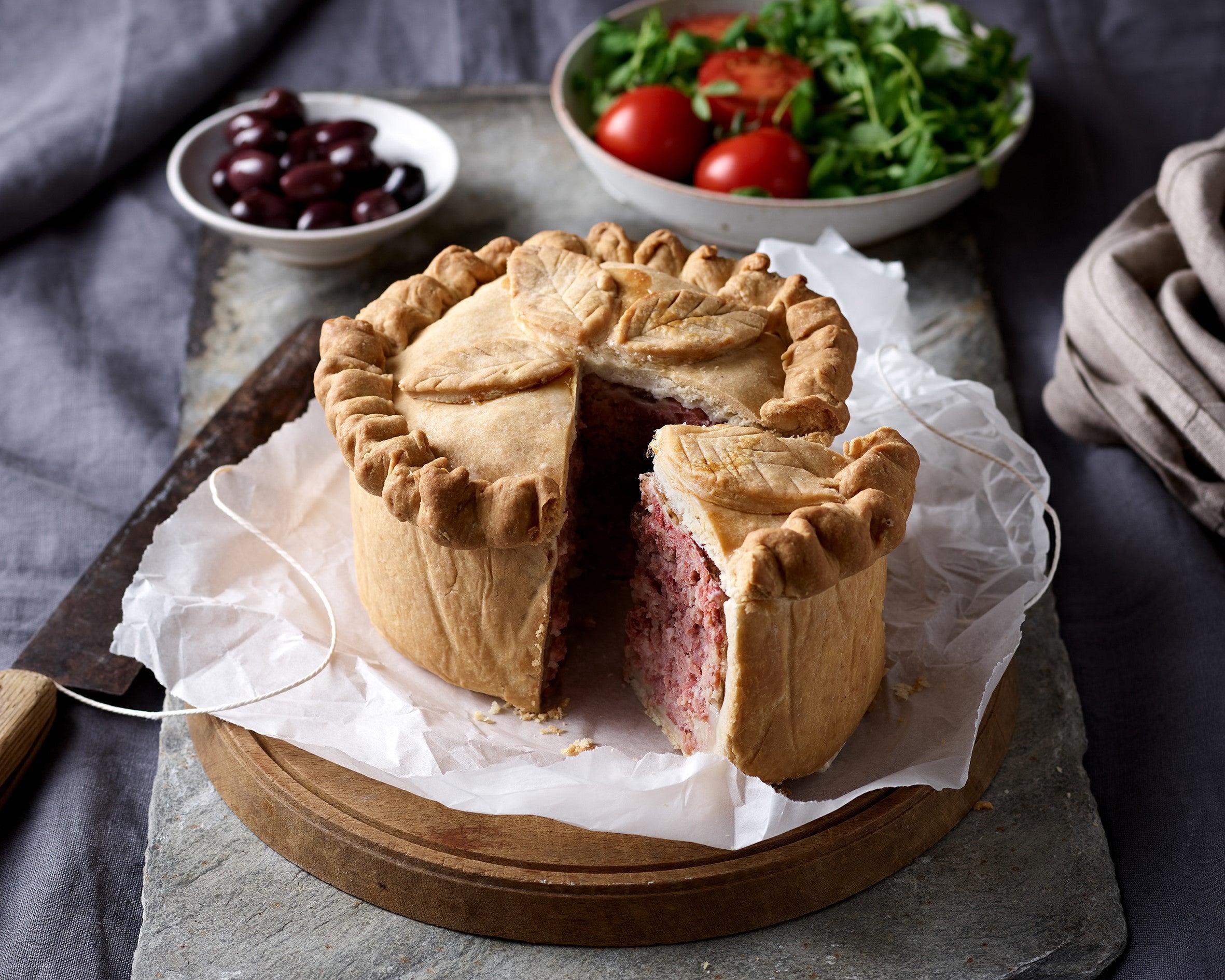
Time: 70-80 minutes
Equipment:
15cm/6” round, loose-bottomed deep cake tin
3cm/1¼” cookie cutter or egg cup
Mixing bowls
Saucepan
Oven tray
Ingredients:
For the hot water pastry:
300g plain white flour
Pinch of salt
1 egg
150ml water
100g lard
Butter, for greasing
For the pork pie filling:
1 tsp chopped sage
½ tsp salt
¼ tsp mace
¼ tsp ground pepper
1 tsp lemon rind, grated
300g minced pork
200g pork sausage meat
200g bacon cubes
Method:
1. Pre-heat your oven to 170C (150C/325F fan/gas 3).
For the hot water pastry:
2. Put the flour and salt into a bowl and stir to combine.
3. Break the egg into the middle of the flour. Beat the egg, in the bowl, combining it with the flour until it is dispersed through the flour.
4. Measure the water into a saucepan, add the lard and put over a medium heat.
5. As soon as the pan comes to the boil, remove it from the heat.
6. Pour the hot liquid into the flour mixture while stirring.
7. Using your hands, gather the mix together to form a soft and smooth ball of dough.
8. Cover and leave for 20 minutes.
For the pork pie filling:
9. Measure the sage, salt, mace and ground pepper into a small bowl and stir to combine.
10. Finely grate the lemon rind into the bowl and stir to make the seasoning mix.
11. Put the pork mince, sausage meat and chopped bacon into a mixing bowl and mix together well.
12. Stir in the seasoning mix.
For the raised pork pie:
13. Rub butter generously around the base and sides of a 15cm/6” round, loose-bottomed, deep cake tin or insert a baking liner.
14. Take two thirds of the pastry and press it into the bottom and sides of the dish.
15. Tip the pie filling into the pastry-lined tin and smooth the top.
16. Moisten the pastry rim with water.
17. Lightly dust the work surface with flour, put the remaining dough in the middle and sprinkle it with more flour.
18. Roll the pastry into a 15cm/6” circle.
19. Brush a little water around the circumference of the pastry circle.
20. Press a 3cm/1¼” cookie cutter or egg cup into the centre of the pastry and remove the small pastry circle. This will allow steam to escape during cooking.
21. Transfer the pastry circle over the filled pie, inverting it so the moistened side is down.
22. Press, pinch or crimp together the outside edges using your fingers or the flat prongs of a fork.
23. Brush the remaining beaten egg over the top of the pie.
24. Place the pie on an oven tray and bake for 70-80 minutes until golden.
25. Allow the pie to cool completely in the tin.
26. Carefully push and lift the cold pie out of the tin.
27. Wrap the pie and refrigerate. Best eaten within 3-4 days.
White rye and herb scones
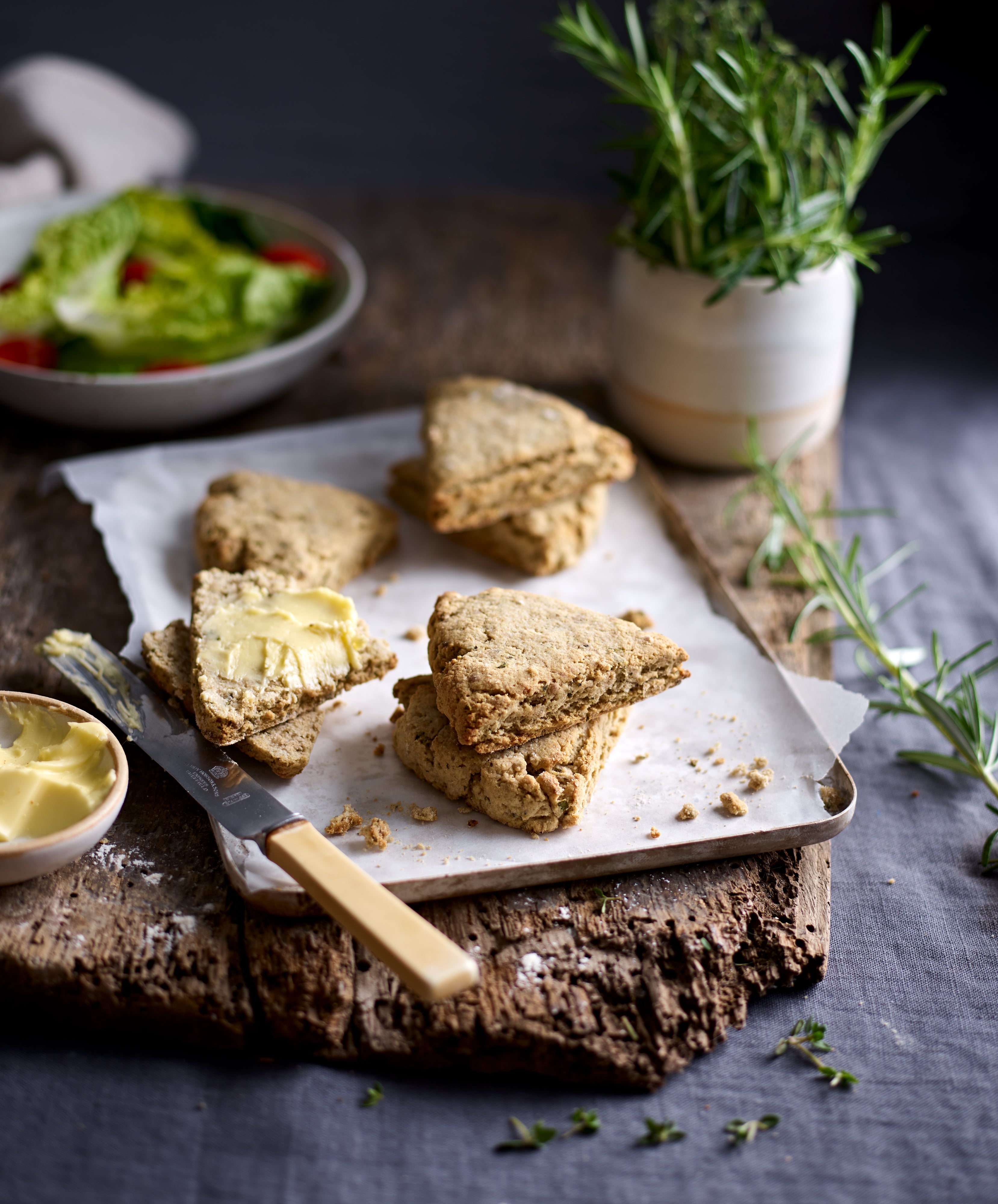
Time: 18-20 minutes
Equipment:
Large baking tray
Mixing bowl
Ingredients:
200g white rye flour
4 tsp baking powder
1 tsp sage
1 tsp rosemary
1 tsp thyme
1 tsp sugar
¼ tsp salt
¼ tsp black pepper
4 tbsp olive oil
125ml water
Flour, for dusting
Method:
1. Pre-heat your oven to 220C (200C/425F fan/gas 7).
2. Dust a large baking tray with flour.
3. Measure the flour and baking powder into a bowl, stir to combine and sieve into a mixing bowl.
4. Add the sage, rosemary, thyme, sugar, salt and pepper and blend together well.
5. Sprinkle the oil over the flour and using a fork, blend everything together until the mixture resembles breadcrumbs.
6. Add enough water, stirring to form a soft, sticky dough. Do not overmix.
7. Gather together the dough into a rough ball and transfer it to the prepared baking tray.
8. Dust the top with flour and gently flatten the dough with your hands, into a circle 3cm/1¼” thick.
9. Cut the dough into six wedges pushing them apart with the knife to make a 2cm/¾” space between each.
10. Bake for 18-20 minutes.
11. Transfer the triangular scones to a wire rack to cool.
Vegan sausage rolls
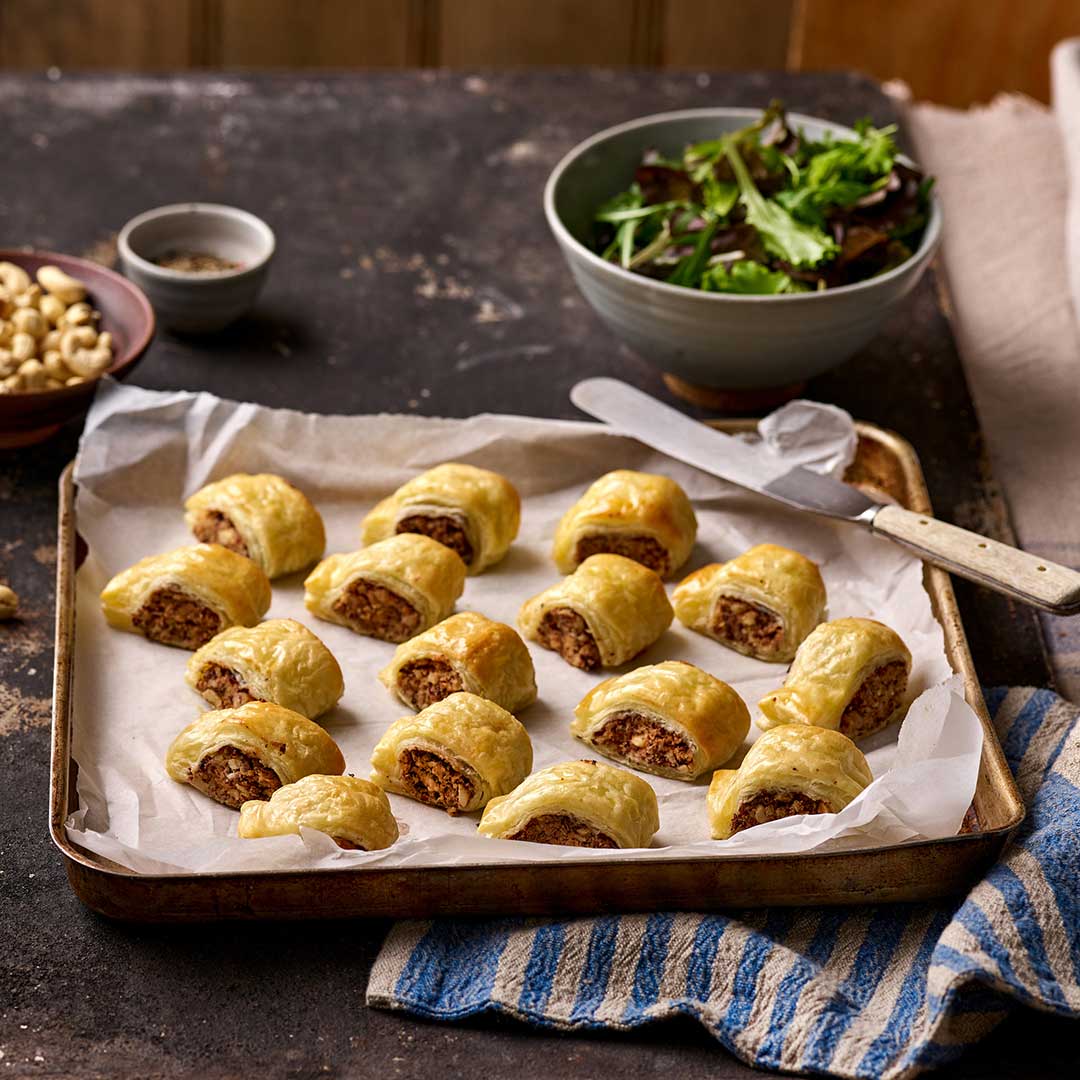
Time: 15-20 minutes
Equipment:
Large baking tray
Blender
2 mixing bowls
Ingredients:
For the vegan flaky pastry:
200g plain white flour
¼ tsp salt
125g vegan baking block, chilled
8 tbsp cold water
Flour, for dusting
For the vegan sausage filling:
50g cashew nuts
1 tbsp rice flour
½ tsp xanthan gum
1 tsp dried sage
½ tsp paprika
½ tsp ground mace
½ tsp salt
¼ tsp ground pepper
200g can kidney beans
Oil, for baking tray
Method:
For the vegan flaky pastry:
1. Put the flour into a bowl, add the salt and stir to combine.
2. Cut the chilled vegan baking block into thin slices and lay them out on a plate.
3. Take about a third of the baking block and add it to the mixing bowl.
4. Using a fork or pastry blender, work the baking block into the flour until the mixture resembles fine breadcrumbs. Avoid using your fingers for this.
5. Add the water and stir until the pastry starts to hold together.
6. Gather the mixture into a ball of soft dough. If the dough seems dry, add another teaspoon of water or if it is excessively wet, cover and rest for 5 minutes.
7. Dust the work surface with flour, place the dough in the middle and dust it with flour.
8. Gently roll the dough into a 20 x 30cm/8 x 12″ rectangle.
9. Lay a second third of baking block slices across the middle of the dough in lines which just touch.
10. Run a damp finger all around the outside of the pastry rectangle.
11. Gently lift the left side of the pastry over and onto the middle of the baking block.
12. Now lift the right side of the pastry, folding it over so the baking block is covered.
13. Press around the edges and pinch together any cracks.
14. Gently fold the pastry in half, pinching any cracks to make sure no baking block is exposed.
15. Dust the pastry with flour, turn it over and dust the other side.
16. For the second time, roll the dough into a 20 x 30cm/8 x 12″ rectangle.
17. Arrange the remaining slices of baking block in lines covering the middle of the pastry and finishing 1cm/⅜” from the sides.
18. Run a damp finger all around the outside of the pastry rectangle.
19. Once again, carefully lift the left and right sides of the pastry over the baking block to meet in the middle.
20. Press around the edges, pinching any cracks to make sure no baking block is exposed.
21. Gently fold the pastry in half for a final time.
22. Dust the folded pastry with flour and chill for at least 10 minutes or up to 4 hours.
For the vegan sausage filling:
23. Put the cashews, rice flour, xanthan gum, sage, paprika, ground mace, salt and pepper into a blender and pulse until finely chopped.
24. Drain the kidney beans, reserving the liquid for later, add the beans to the blender and pulse until the mixture holds together.
25. Divide the mixture into four equal pieces and roll each into a 23cm/9” cylinder.
For the vegan sausage rolls:
26. Pre-heat your oven to 220C (200C/425F fan/gas 7).
27. Allow the pastry to come back to room temperature.
28. Rub some oil around the inside of a large baking tray or insert a baking liner.
29. Dust the work surface and pastry with flour.
30. Roll the pastry into a 40 x 25cm/16 x 10” rectangle.
31. Cut the pastry into four 10 x 25/4 x 10” lengths.
32. Place a vegan sausage cylinder onto each pastry length.
33. Brush the reserved bean liquid all over the pastry.
34. Gently lift the long edges of pastry over the sausage to enclose it.
35. Press to seal the edges with a fork.
36. Lightly press the back of the fork into the top of the long sausage roll to create ridges.
37. Brush the remaining bean liquid over the pastry.
38. Cut the sausage rolls into 3cm/1¼” slices.
39. Transfer the slices to the prepared baking tray.
40. Chill the sausage rolls for at least 10 minutes or up to 4 hours.
41. Bake for 15-20 minutes.
42. When completely cold store in a tin or freeze.
43. To re-heat from frozen bake for 15 minutes.

Time: 12-18 minutes
Equipment:
2 x 12-hole tart trays
Plain or scalloped round pastry cutters
Pastry blender
Mixing bowl
Ingredients:
150g plain white flour
75g butter
50g caster sugar
6 tbsp cold water
200g jam
Butter, for greasing
Flour, for dusting
Method:
1. Pre-heat your oven to 180C (160C/350F fan/gas 4).
2. Put the flour into a mixing bowl.
3. Chop the butter into small cubes and add them to the bowl.
4. Using a pastry blender or fork, work the butter cubes into the flour until it resembles breadcrumbs.
5. Stir in the sugar.
6. Stir in enough water to bring together a soft ball of dough.
7. Cover the dough and leave it to stand for 15 minutes.
8. Rub a little butter around the insides of 2 x 12-hole tart trays.
9. Dust the work surface with flour, put the pastry in the middle and sprinkle it with more flour.
10. Roll out the dough until about 1.5mm/1/16” thick.
11. Select a pastry cutter or cup a little bigger than the holes of a tart tray and press it into the dough to make circles.
12. Lift the pastry circles on to the prepared tray.
13. Gather up the off cuts into a ball of dough, roll it out again and cut more circles for the second tray.
14. Put a scant teaspoon of jam in the centre of each tart.
15. Bake for 12-18 minutes depending on size.
Recipes from www.dovesfarm.co.uk
[title_words_as_hashtags



